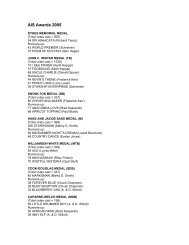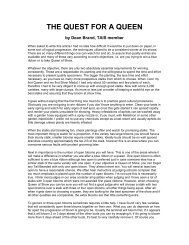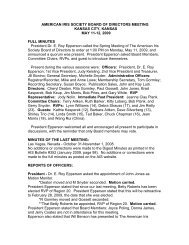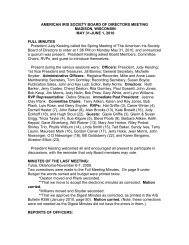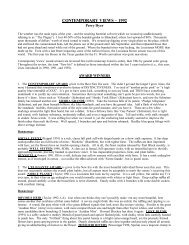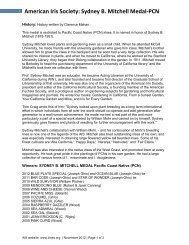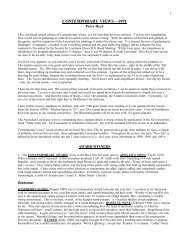contemporary views – 1988 award winners - American Iris Society
contemporary views – 1988 award winners - American Iris Society
contemporary views – 1988 award winners - American Iris Society
Create successful ePaper yourself
Turn your PDF publications into a flip-book with our unique Google optimized e-Paper software.
irises I’ve seen, I don’t ever recall seeing one with a beard quite that color, and it was most appealing. Taller and more<br />
stately than most from the Corlew line.<br />
The precursors to pinks with true blue beards are for real and they are here now. I predict a true pink with a true, intense,<br />
solid blue beard will be on the market by the end of this next decade. MAGIC (Hager 1987) was the most improved<br />
variety in Oklahoma this year. The intensity of pink is similar to ‘Pink Sleigh’ but the quality of color will vary from<br />
year to year and from one area to another, too, unfortunately. This was one of the good years. The beard was so deep it<br />
approached purple. I don’t know it if was magic but rather some innovative, intuitive, patient hybridizing that produced<br />
this breakthrough. Warmer, drier weather cleans up the “mud” of the blue-pink, yet doesn’t deteriorate the intensity of the<br />
beard. GIFT OF DREAMS (Hamblen 1987) bloomed a week after convention and might not have been seen by many. It<br />
is taller and deeper than its mother, ‘Sophistication’ (Hamblen). The color is actually a smoky effect. The beard is more<br />
intense and holds its saturation well in warm weather also. But the most elegant is still the first one,<br />
SOPHISTICATION (Hamblen 1984), one of my favorites and most beautiful of all irises. It is a pastel but not pale satin<br />
pink with a soft but noticeable true blue beard. Early reports were that the beard would fade out in warmer weather, but I<br />
have found this statement to be untrue in Oklahoma. Wonder how many different hybridizers crossed ‘Sophistication’<br />
with ‘Magic’ this spring?<br />
CLASSICS: PINK TAFFETA (Rudolph 1968); PINK SLEIGH (Rudolph 1970); VANITY (Hager 1975); BUFFY<br />
(O. Brown 1969); PINK ANGEL (Rudolph 1973).<br />
LAVENDERS TO VIOLETS:<br />
There are so many varieties in this highly developed class that a new variety must really have charisma to merit attention.<br />
THRILLER (Schreiner <strong>1988</strong>), a runnerup for the Contemporary Award, is a vigorous, floriferous claret-violet with deep<br />
purple beards that are nearly black. Large blossoms have a rather informal, airy look, but they maintain their shape.<br />
Branching and bud count are the best of this series from the Schreiners, with stalks consistently throwing 3 branches. The<br />
finish is done in a rich satin sheen. EVER AFTER (Keppel 1986) is a large, full-blown fuchsia with an appealing lighter<br />
area in the heart of the falls around the red beards. The blocky form has a “rolled-back”, almost recurving look that could<br />
be a defect in certain color patterns, but is enhancing with this one. Taller, better branched, certainly more vigorous, and a<br />
more attractive color than its parent, ‘Mulled Wine’ (Keppel).<br />
BUBBLING OVER (Ghio 1982) is one of the most beautiful individual flowers in irisdom. A heavily ruffled orchid that<br />
approaches lilac, with white to self beards. It is nice to see this color without the traditional tangerine-red beards for a<br />
change. Sometimes a flower can be so heavily bubbled ruffled that it is overstated. Sometimes they are so intense they<br />
have difficulty opening, like a laced iris. But with ‘Bubbling Over’, the depth and space of each ruffle is exact and perfect,<br />
and makes for an elegant creation. The foliage is clean and healthy and of average increase. The branching is close to the<br />
stalk, but not defective. Unfortunately, ‘Bubbling Over’ is consistently “missing” a lower branch, and this is the main<br />
reason I personally won’t consider it for a higher <strong>award</strong>.<br />
CLASSICS: LILAC FLARE (Rudolph 1969); LILAC RUFFLES (Rudolph 1971); BEAUX ARTS (Plough 1969).<br />
CREAMS TO LIGHT YELLOWS:<br />
The new star is the seedling Gatty N49-2 (now named HOLLYWOOD BLONDE, a 1989 introduction), a classic,<br />
sparkling light yellow in the color range of ‘Lemon Mist’ (Rudolph), but with perfect, moderate lace on all parts. A clean,<br />
simple color, with diamond dusting throughout that gives carrying power in the garden. It has 3-way branching, well<br />
spaced on strong stalks. Joe’s PRECIOUS MOMENTS (1983) was as beautiful as it has ever been, and had better vigor<br />
and stalks than previous years. A broad, bold blending of clean pale yellow and sparkling white. The ruffling is moderate<br />
and classical. FIRST IMPRESSION (1985) is more of a pure cream with the same form and ruffling, but with a more<br />
opaque, leathery finish. CHURCHILL DOWNS (K. Mohr <strong>1988</strong>) was seen in only one garden, but this lemon yellow<br />
with white in the center of the falls appears to have the potential to be an improvement over one of my personal favorites,<br />
Hamblen’s ‘Ruffles and Lace’. Broad form with tight, finely applied lace and ruffling. BUTTER CRISP (Aitken 1986) is<br />
a charming, small flowered butter yellow and creamy white blend with tight, compact form. Advertised as a Small Tall, it<br />
fit the billing perfectly, and actually comes closer to being a good Border Bearded than some of the registered not-so-Border<br />
Beardeds on the market! ‘Butter Crisp’ is overly floriferous, even blooming out in one garden, so you gardeners with lush<br />
rich soil will need to be sure to underfeed it. SUNKIST FRILLS (D. Palmer 1987) blooms very late in the season. It<br />
was a<br />
6




